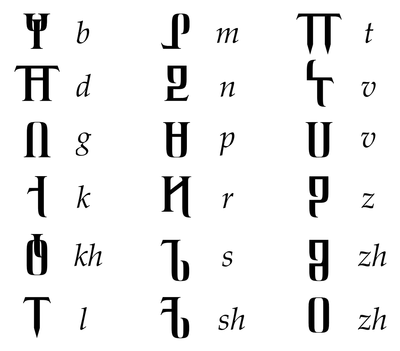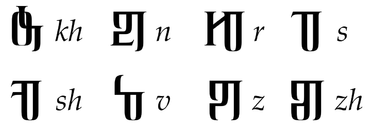Appendix:Aazh Naamori orthography: Difference between revisions
No edit summary |
No edit summary |
||
| Line 36: | Line 36: | ||
* https://dedalvs.com/work/vampire-academy/misc/moroi_pronunciation.pdf | * https://dedalvs.com/work/vampire-academy/misc/moroi_pronunciation.pdf | ||
[[Category:Aazh Naamori language|Orthography]][[Category:Script appendices]] | [[Category:Aazh Naamori language|Orthography]] | ||
[[Category:Aazh Naamori appendices|Orthography]] | |||
[[Category:Aazh Naamori script| ]] | |||
[[Category:Script appendices]] | |||
Latest revision as of 07:55, 21 January 2024
The Aazh Naamori language from Peacock's Vampire Academy is written using an abugida created by David J. Peterson and Jessie Peterson.
Orthography
Aazh Naamori is written with an abugida, meaning that the script consists of base consonant glyphs which are modified to indicate the quality of the following vowel.
Consonants
Consonant glyphs form the basis of each written consonant-vowel sequence. The basic unmodified glyphs are shown below:
Coda consonants
Certain consonant glyphs may appear in coda position, and their shapes are altered in such cases. These glyphs are used at the end of a word, and if used within a word they usually indicate that the previous vowel is long. The glyphs are shown as follows:
Vowels
Consonant glyphs can be pronounced with (or without) an inherent a vowel after it. They may be modified by diacritics in order to represent a following i or u vowel:
The o vowel is written as the orthographic sequence wu, and correspondingly, the vowel e is written as yi:
Word-initial vowels
There is a glyph which historically signified h, a sound which is no longer part of the modern language. This now lives on as what is effectively a 'carrier' glyph for word-initial vowels:




